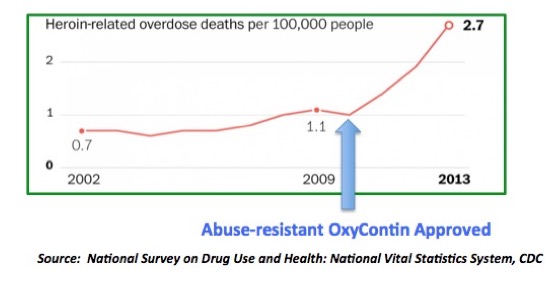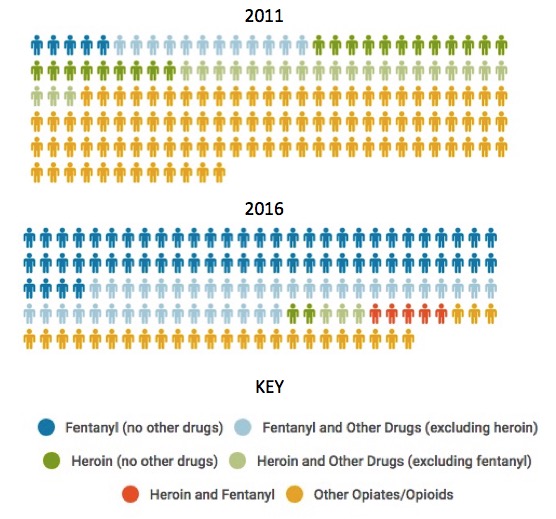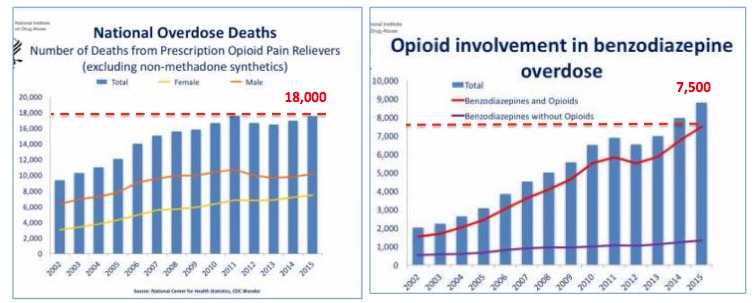
CNN has just figured out something that we at the Council have been saying for more than a year. The narrative that opioid pills, such as Vicodin (hydrocodone) and Percocet (oxycodone) are causing addicts to drop dead left and right is absolutely false. (See: American Council On Science And Health — FDA Science Board Meeting Testimony On Opioids).
The network just acknowledged that the pervasive and convenient belief about pills is wrong. As we have written numerous times, it is fentanyl—an "opioid on steroids"—that is the culprit.
About 75 percent of the state's men and women who died after an unintentional overdose last year had fentanyl in their system, up from 57 percent in 2015. It's a pattern cities and towns are seeing across the state and country, particularly in New England and some Rust Belt states.
Martha Bebinger writing for CNN. April 11, 2017
The evidence has been clear for years. When pills become scarce, addicts turn to heroin, which now often contains fentanyl (see Fig. 1). A 2014 study found that 94 percent of heroin users said that they switched to heroin because the pills became “far more expensive and harder to obtain.” (1)

Fig. 1- Once OxyContin - the primary driver of opioid addiction - was finally reformulated in 2010 to make it much harder to abuse, it's use plummeted, while at the same time, heroin use soared.
Nowhere is this trend clearer than in New Hampshire. 
Overdose deaths in New Hampshire, 2011-2016. Source: Office of the medical examiner
The picture above shows what is really happening. In 2011, only three percent of overdose deaths in the state were due to fentanyl alone, and another eight percent were from fentanyl plus another drug (other than heroin). Heroin, either alone or in combination with drugs other than fentanyl was responsible for 28 percent of overdose deaths.
But in 2016, the story was very different. Fentanyl (alone) caused 27 percent of overdose deaths, and when combined with other drugs, that number became 70 percent. During this same time, the incidence of heroin-related deaths (excluding fentanyl) plummeted from 28 percent to three percent. Within just five years, the two drugs traded places. The magnitude of this change reflects the extent of penetration of fentanyl into the US. At least in New Hampshire, fentanyl has essentially wiped out the heroin market.
Even though the incidence of pill-only deaths (17 percent) is relatively low, this number is nonetheless inflated. Forty-three percent of opioid pill deaths nationwide are due to a combination of the opioid plus a benzodiazepine, such as Valium (2). So the actual incidence of pill-only deaths (assuming that the national figures apply to those of New Hampshire) would be 9 percent, and probably less (3). This is shown in Figure 2. 
Fig. 2 Total national overdose deaths from opioid pills (left). The involvement of benzodiazepines in opioid deaths (right). Source: NIH
The "pills kill" narrative we constantly hear is false. At least in New Hampshire, pills are not the main problem (4). Fentanyl is, which became popular only after the pills were harder to get—as good an example of the law of unintended consequences as you'll ever see.
Which makes me wonder if the state should change its motto: Live Pill Free or Die?
The false narrative about the dangers of opioid pills has us looking at the wrong villain, and the consequences of this error are terrible. People with a legitimate need for pain drugs are terrified about being cut off from their medicines, while the real monster just sits and laughs at us.
Next: The second false narrative - the myth of addiction from legitimate use of prescribed opioid drugs.
Notes:
(1) See: Cicero TJ, Ellis MS, Surratt HL, Kurtz SP. The changing face of heroin use in the United States: a retrospective analysis of the past 50 years. JAMA Psychiatry. 2014;71(7):821–826. doi:10.1001/jamapsychiatry.2014.366.Notes:
(2) The combination of an opioid plus a benzodiazepine is not only more dangerous than either alone, but is more so than a simple addition of each drug's independent risk. There is a pharmacological synergy between the two.
(3) Opioid pills are also consumed with other drugs, such as alcohol and cocaine. It is all but certain that the 9 percent figure for opioid-only deaths is inflated.
(4) Very similar numbers can be found in Department of Health reports from a number of states, including Florida, Ohio, Pennsylvania, and Massachusetts. This is not a New Hampshire problem.



